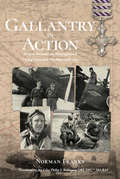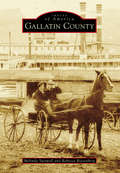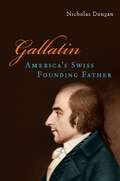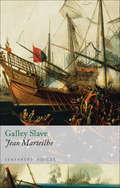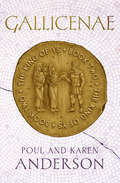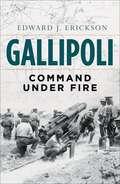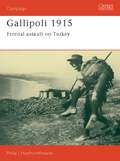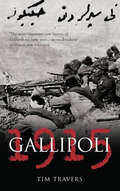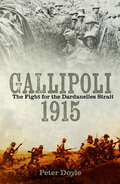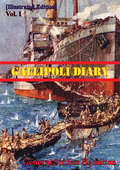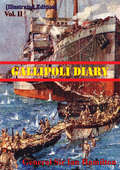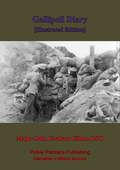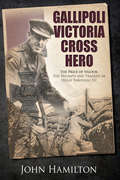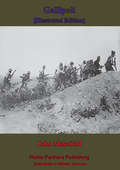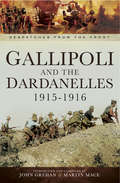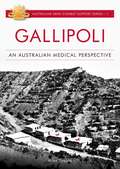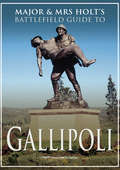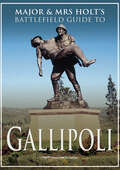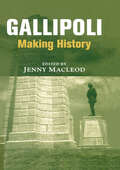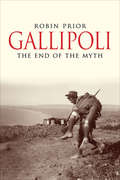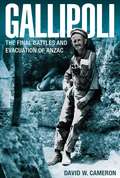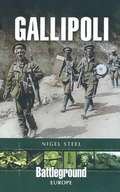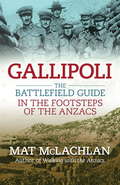- Table View
- List View
Gallantry in Action: Airmen Awarded the Distinguished Flying Cross and Two Bars 1918—1955
by Norman FranksA who&’s who of the British airmen honored for their valor and courage—from the RAF&’s inception to the post-WWII era—arranged alphabetically. When the Royal Flying Corps and the Royal Naval Air Service merged on 1 April 1918, to form the Royal Air Force, the new command needed to have its own gallantry medals to distinguish itself from the Army and the Royal Navy. Thus the new Distinguished Flying Cross came into being. By the end of WWI, only three Second Bars had been promulgated for First War actions. Before WWII erupted, four more Second Bars had been awarded, and fifty were added to this total by the conflict&’s end. Three more were awarded post-WWII, between 1952–1955, making a grand total of sixty. Still a significantly small number of members of this pretty exclusive &“club.&” Within the covers of this book recorded for the first time together are the mini-biographies of all those sixty along with the citations that accompanied their awards, or in some cases the recommendations for them. Also recorded are citations for other decorations such as the Distinguished Service Order, et al. As the reader will discover, the range of airmen who received the DFC and Two Bars, cover most of the ambit of WWII operations, be they fighter pilots, bomber pilots, night-fighter aircrew, aircrew navigators, engineers, etc., or reconnaissance pilots. Each has interesting stories, proving, if proof be needed, their gallantry in action.
Gallatin County (Images of America)
by Melinda Sartwell Rebecca RiesenbergTucked away on the banks of the Ohio River, Gallatin County is a hidden gem that embodies the essence of historic Kentucky regions. Formed in 1798, the county boasted a desirable combination of rolling farmlands and favorable river frontage that was vital for early pioneers as they moved west to settle the frontier. The county's location along river and shipping routes between Cincinnati and Louisville provided both a bustling economy and a rural lifestyle for its residents. The decline in river traffic and the construction of Interstate 71 in the 1960s largely left the county behind and dramatically impacted the local economy. As homage to its pioneering roots, Gallatin County has revitalized its economy with a busy marina, two major employers (Gallatin Steel and Dorman Products), and the spectacular Kentucky Speedway while retaining its rural historical charm.
Gallatin: America's Swiss Founding Father
by Nicholas DunganYou won’t find his portrait on our currency anymore and his signature isn’t penned on the Constitution, but former statesman Albert Gallatin (1761-1849) contributed immeasurably to the formation of America. Gallatin was the first president of the council of New York University and his name lives on at NYU’s Gallatin School of Individualized Study, so it is with pride that New York University Press and the Swiss Confederation publish this new biography of Gallatin.Gallatin’s story is the opposite of the classic American immigrant tale. Born in Geneva, the product of an old and noble family and highly educated in the European tradition, Gallatin made contributions to America throughout his career that far outweighed any benefit he procured for himself. He got his first taste of politics as a Pennsylvania state representative and went on to serve in the U.S. Senate and House of Representatives. Gallatin became the Secretary of Treasury in Jefferson’s administration and, despite being of the opposite political party to Alexander Hamilton, Gallatin fully respected his predecessor’s fiscal politics. Gallatin undertook a special diplomatic mission for President Madison, which ended the War of 1812 with the signing of the Treaty of Ghent and gave the United States its genuine independence. Gallatin continued in diplomacy as minister to France and to Great Britain, where he skillfully combined his American experience and European background. In the early 1830s, at the age of seventy, he retired from politics and commenced a new career in New York City as a banker, public figure, and intellectual. He helped establish New York University and the American Ethnological Society, became an expert in Native American ethnology and linguistics, and served as president of the New-York Historical Society. Gallatin died at age 88 and is buried in Trinity churchyard at Broadway and Wall Street.In our own day, as we look at reforming our financial system and seek to enhance America’s global image, it is well worth resurrecting Albert Gallatin’s timeless contributions to the United States, at home and abroad. Nicholas Dungan’s compelling biography reinserts this forgotten Founding Father into the historical canon and reveals the transatlantic dimensions of early American history.Co-published with the Swiss Confederation, Federal Department of Foreign Affairs.
Gallaudet: Friend of the Deaf
by Etta DegeringOn a May day in 1814, while watching his younger brothers and sisters at play, Thomas noticed a small girl taking no part. She was Alice Cogswell, and deafness shut her out of the circle. The lack of language created a barrier between her and her friends. Thomas invented a game that helped Alice for the first time in her life to understand that things have names. Thomas knew what he could do. He knew he had to bring education for the deaf to America!
Galley Slave: The Autobiography of a Protestan Condemned to the French Galleys (Seafarers' Voices)
by Jean MarteilheThis remarkable memoir tells of the miseries of Jean Marteilhe of Bergerac, a Protestant condemned to the Galleys of France for his Religion, who, after the revocation of the Edict of Nantes in 1685, attempted, like so many French Huguenots, to escape to the more sympathetic Protestant countries bordering France. In 1700, heading through the Ardennes towards Charleroi, he was captured by French Dragoons and thrown into gaol.In 1707 he then found himself, like so many Huguenots, condemned to serve in the French Mediterranean galleys. Little is known of life as a galley slave on these oared vessels. Certainly no accounts have come down to us from ancient Greece or Rome, though a little is known from the time of the Crusades. So Marteilhes racy account represents the only authentic record of the miseries of a galley slave who experienced all the horrors of whips and chains and the dreaded bastinado—foot whipping.For six years he pulled his oar, often seeing friends and co-religionists lashed—sometimes to death—under the whips of the overseers. He himself sustained almost fatal injuries in a bloody engagement with the British off the mouth of the Thames before being released under a general amnesty in 1713.Galley Slave brings vividly to life the sufferings and conditions on the seventeenth- and eighteenth-century galleys and is a unique and unforgettable account.
Gallicenae (The King of Ys #2)
by Poul Anderson Karen AndersonIn book two of the King of Ys series, Gratillonius adjusts to his new role as sovereign of Ys as threats from all sides begin closing in As the Roman Empire loses its grip on its far-flung territories, the mystical kingdom of Ys in western Gaul is in great danger of slipping into oblivion. Suffocated for years by the rule of a tyrant king, Ys&’s last hope arrived in the form of a Roman emissary, Gratillonius, who defeated the sitting king to take the throne himself. Now Gratillonius must grapple with the kingdom&’s political strife and religious tensions while balancing his responsibilities to the Gallicenae, nine wide-ranging witches who have become his wives. Though Rome seeks to spread Christianity, and Gratillonius stands firm in his worship of Mithras, the Ysans hold to an entirely different religion in service of pagan deities who must be obeyed lest grave consequences descend on the fragile kingdom. Gallicenae is the second book in Poul and Karen Anderson&’s King of Ys series, which continues with Dahut.
Gallipoli
by Edward J. EricksonUnique among World War I campaigns, the fighting at Gallipoli brought together a modern amphibious assault and multi-national combined operations. It took place on a landscape littered with classical and romantic sites - just across the Dardanelles from the ruins of Homer's Troy. The campaign became, perhaps, the greatest 'what if' of the war. The concept behind it was grand strategy of the highest order, had it been successful it might have led to conditions ending the war two years early on Allied terms. This could have avoided the bloodletting of 1916-18, saved Tsarist Russia from revolution and side stepped the disastrous Treaty of Versailles - in effect, altering the course of the entire 20th century. This book is the first to focus on operational and campaign level decisions and actions, which drove the conduct of the campaign. It departs from emotive first-hand accounts and offers a broader perspective of the large scale military planning and maneuvring involved in this monstrous struggle on the shores of European Turkey.
Gallipoli 1915
by Philip HaythornthwaiteThe Gallipoli expedition of 1915, the brainchild of Winston Churchill, was designed to knock the Turkish Empire out of the First World War and open a supply route to Russia. The campaign is characterised by the military incompetence of the higher commands, particularly the Allies. However, in spite of this, Gallipoli deserves to be, and is, also remembered for the heroism and resourcefulness of both the British army and the men of the Australian and New Zealand Army Corps. This book details the battles, hardships and eventual evacuation that these men had to go through, in this comprehensive guide to the Gallipoli landings of World War I (1914-1918).
Gallipoli 1915
by Tim TraversWhy was the Allied naval assault of February/March 1915 so unsuccessful? Did the Ottoman Turks have knowledge of the Allied landings of 25 April 1915? And did Sir Ian Hamilton, the overall commander of the Allied forces at Gallipoli, really make a mistake in his intervention at Suvla? These questions and the key issue of why the Ottoman Turks won the 1915 Gallipoli campaign, or why the Allies lost it, have never been satisfactorily answered.This new history of the Gallipoli campaign aims to answer them, while also telling the story of what actually happened through the voices of British, Australian and Turkish soldiers. In order to properly understand the bloody events of 1915, Tim Travers is the first historian of Gallipoli to use the general Staff Ottoman archives in Ankara to tell the other side of the story. Wide-ranging research in the Turkish archives as well as those in Australia, Britain, France and New Zealand, plus a significant newly discovered German source, has produced a startling new interpretation of the 1915 conflict. Moving from a study of the Western Front, Tim Travers has produced a challenging analysis of the enduring mysteries of the Gallipoli campaign.
Gallipoli 1915: The Fight for the Dardanelles Strait
by Peter DoyleIn a campaign part sponsored by First Lord of the Admiralty Winston Churchill, the Battle of Gallipoli in 1915 remains one of the most resounding Allied defeats of the First World War, with both the Allied and Ottoman armies suffering in excess of 200,000 casualties.Despite this, many believed it would be a sure-fire success due to the preceding naval campaign, but increased losses at sea prompted the Allies to send in ground troops. Comprising a large ANZAC contingent on their first major operation, they were tasked with invading and eliminating the formidable Ottoman artillery.On 25 April 1915, they landed on five stretches of beach in open boats. The casualties from the first landing were horrific: of the first 200 men out of the boats, only twenty-one reached inland, the rest being mown down by Ottoman machine guns. Casualties only accelerated from there for both sides, until the Allies were forced to evacuate. Gallipoli 1915 takes you to the front line and beyond, ensuring that you will appreciate the ultimate sacrifice made by these brave soldiers.
Gallipoli Diary Vol. I [Illustrated Edition] (Gallipoli Diary #1)
by General Sir Ian Standish Monteith Hamilton GCB GCMG DSO TDudes Gallipoli Campaign Map and Illustrations Pack -71 photos and 31 maps of the campaign spanning the entire period of hostilities.The desperate losses and ultimate failure of the Gallipoli campaign are legendary even among the holocaust of the First World War. The man ultimately held responsible for the failure was General Ian Hamilton, the officer in charge of the operation; criticism has been heaped on him since the last Allied soldier left the Turkish peninsula in 1915. His diaries however paint a different picture; that of a General struggling with a task that was night-on impossible to begin with;Thrust in to a mad-cap operation he was given the scantest of details;"But my knowledge of the Dardanelles was nil; of the Turk nil; of the strength of our own forces next to nil. Although I have met K. almost every day during the past six months, and although he has twice hinted I might be sent to Salonika; never once, to the best of my recollection, had he mentioned the word Dardanelles."Short of men, supplies and most all ammunition; his failure was not from a lack of effort. Fighting uphill against an entrenched enemy, the ground that he and his men fought over was some of the toughest on Earth to attack. Always too close to the fighting line he was out of his depth with the strategic thinking necessary in an army commander.There is much in his diaries that is of interest the serious student of the Gallipoli campaign and the casual reader of the story of the First World War.
Gallipoli Diary Vol. II [Illustrated Edition] (Gallipoli Diary #2)
by General Sir Ian Standish Monteith Hamilton GCB GCMG DSO TDIncludes Gallipoli Campaign Map and Illustrations Pack -71 photos and 31 maps of the campaign spanning the entire period of hostilities.The desperate losses and ultimate failure of the Gallipoli campaign are legendary even among the holocaust of the First World War. The man ultimately held responsible for the failure was General Ian Hamilton, the officer in charge of the operation; criticism has been heaped on him since the last Allied soldier left the Turkish peninsula in 1915. His diaries however paint a different picture; that of a General struggling with a task that was night-on impossible to begin with;Thrust in to a mad-cap operation he was given the scantest of details;"But my knowledge of the Dardanelles was nil; of the Turk nil; of the strength of our own forces next to nil. Although I have met K. almost every day during the past six months, and although he has twice hinted I might be sent to Salonika; never once, to the best of my recollection, had he mentioned the word Dardanelles."Short of men, supplies and most all ammunition; his failure was not from a lack of effort. Fighting uphill against an entrenched enemy, the ground that he and his men fought over was some of the toughest on Earth to attack. Always too close to the fighting line he was out of his depth with the strategic thinking necessary in an army commander.There is much in his diaries that is of interest the serious student of the Gallipoli campaign and the casual reader of the story of the First World War.
Gallipoli Diary [Illustrated Edition]
by Major John Graham Gillam D.S.O.Even during the horrors of the brutalizing industrialised slaughter of the First World War the Gallipoli campaign stands as a benchmark for the awful conditions and savage fighting that occurred. The narrow strips of land that the British, Australian, New Zealand and other Dominion troops tried to wrest from the dogged Turkish defenders was under constant shellfire and every item had to be dragged to the frontline under this hellish barrage. Captain (as at the time) Gillam was part of the supply service who risked their lives to get, food, clothing and ammunition up to the troops in the front-line. Gillam gives a clear, concise account not only of the dangers that he faced, but also the men that he served so ably in the front-line.His diary covers his time on the Gallipoli Peninsula from his landing at Capes Helles (W Beach-Lancashire Landing) on April 25th 1915, and the landing at Suvla Bay, until the eventual evacuation of the troops in early 1916. There have been many Author --Major John Graham Gillam DSO d. June 1937Text taken, whole and complete, from the edition published in London, George Allen & Unwin, ltd. 1918.Original Page Count - 328 pages.Illustrations -- 10 illustrations.
Gallipoli Victoria Cross Hero: The Price of Valour: The Triumph and Tragedy of Hugo Throssell VC
by John HamiltonThe WWI biography of a Victory Cross recipient who fought bravely at Gallipoli, only to be shunned after the war for speaking out against it. The son of a former Premier of Western Australia, Hugo Throssell volunteered to join the Imperial Australian Force during the Great War. He was shipped to Gallipoli in 1915 with the 10th Australian Light Horse Regiment, which fought in a dismounted role. He was involved in the famous charge of the 10th Light Horse at the Battle of the Nek and the Battle of Hill 60. Throssell was severely wounded during the Battle of Hill 60, but refused to leave his post until the fighting was over. As soon as his wounds were dressed, he went back into the firing line until he was ordered to stand down by the Medical Officer. His determination saved his battalion at a critical moment. After the war, Throssell became an outspoken opponent of war, for which he was widely condemned. It also made employment difficult and he fell into debt. When he tried to pawn his Victoria Cross, he was offered only ten shillings. He committed suicide at forty-nine. Meticulously researched and beautifully written, this is a moving tale of heroism and tragedy.
Gallipoli [Illustrated Edition]
by John MasefieldFew accounts of the disastrous Gallipoli campaign are as famous as that of John Masefield, and justly so, for so few have captured the danger, death and heroism on the Peninsula. He saw service as a Red Cross orderly in France and sought to alleviate the plight of the soldier and volunteered his services to motor boat ambulance seeing the battles first-hand. Masefield was a poet of great power, later becoming Poet-Laureate, and set to use all of his skills in describing the feats and achievements of the expedition.Published in London and New York simultaneously to wide acclaim this account is a still a classic described by one critic as 'a book to strike the critical faculty numb' and 'too sacred for applause'-- W.H. Hamilton.This edition contains the numerous maps and illustrations that enrich and aid the readers experience.Author -- Masefield, John, 1878-1967.Text taken, whole and complete, from the edition published in New York, The Macmillan company, 1916.Original Page Count - 245 pages.Illustrations -- 9 maps and Illustrations
Gallipoli and the Dardanelles, 1915–1916: Despatches From The Front (Despatches From The Front Ser.)
by John GrehanThe fighting in the Gallipoli or Dardanelles campaign began in 1915 as a purely naval affair undertaken partly at the instigation of Winston Churchill, who, as First Lord of the Admiralty, had entertained plans of capturing the Dardanelles as early as September 1914. It was the Royal Navy that bore the brunt of the initial action, supported by the French and with minor contributions from, the Russian and Australian fleets.On 3 November 1914, Churchill ordered the first British attack on the Dardanelles following the opening of hostilities between Ottoman and Russian empires. The British attack was carried out by battle cruisers of Carden's Mediterranean Squadron, HMS Indomitable and HMS Indefatigable, as well as two French battleships. This attack actually took place before a formal declaration of war had been made by Britain against the Ottoman Empire. Royal Navy submarines had already been operating in the region.When the naval operations failed, a full invasion of the Gallipoli Peninsula was launched. The bitter fighting that followed resonated profoundly among all nations involved. The campaign was the first major battle undertaken by the Australian and New Zealand Army Corps (ANZAC), and is often considered to mark the birth of national consciousness in both of these countries. For the Turkish forces it would prove a major victory.
Gallipoli: An Australian Medical Perspective (Australian Combat Support #1)
by Michael TyquinTo be successful, a modern army needs logistical support to survive - to arm, feed, transport, and care for its soldiers. As history shows us the maintenance of health in any army , is a key factor in warfare. In many respects the Gallipoli campaign was a doomed undertaking. The seeds of ultimate defeat in December 1915 were the risks that attended a hugely ambitious, complex, and large-scale amphibious operation - the landings on well-defended shores on the Gallipoli peninsula, under cover of darkness. Communications at the time were primitive, while general staff officers had little understanding of their own army's medical assets or the needs of a large medical organisation. The Australian Army Medical Corps (AAMC) received aid from, and gave support to, all five forces at various times during 1915. Underlying the execution of the Dardanelles campaign were factors wholly outside the control of the Australian AMS. Undoubtedly tragic, and sometimes avoidable, errors were made at the highest level of command, with subsequent pressures on the AMS. An amphibious operation of this type and scale, however, was without parallel in modern military history, and mistakes were inevitable, as they are with any campaign of such complexity. Gallipoli: An Australian Medical Perspective explores these complexities and mistakes through the eyes of the infant Australian Army Medical Corps.
Gallipoli: Battlefield Guide (Major and Mrs Holt's Battlefield Guides)
by Tonie Holt Valamai HoltThis illustrated guide includes a historical overview of the battle, maps, itineraries, and updated information on memorials, museums, and more. The Battle of Gallipoli was one of the most bitterly fought conflicts of the Great War, and a profound and tragic loss for Entente powers of Britain, France, and Russia. This guidebook to the battlefields and historic sites of Gallipoli is an invaluable asset for any visitor who hopes to get the most out of their trip. Along with complete and updated information on museums, memorials, and war cemeteries, Major and Mrs. Holt provide essential historical overviews and practical itineraries covering all of the battleground sites. FULLY UPDATED
Gallipoli: Battlefield Guide (Major and Mrs Holt's Battlefield Guides)
by Tonie Holt Valamai HoltThis illustrated guide includes a historical overview of the battle, maps, itineraries, and updated information on memorials, museums, and more. The Battle of Gallipoli was one of the most bitterly fought conflicts of the Great War, and a profound and tragic loss for Entente powers of Britain, France, and Russia. This guidebook to the battlefields and historic sites of Gallipoli is an invaluable asset for any visitor who hopes to get the most out of their trip. Along with complete and updated information on museums, memorials, and war cemeteries, Major and Mrs. Holt provide essential historical overviews and practical itineraries covering all of the battleground sites. FULLY UPDATED
Gallipoli: Making History (Military History And Policy Ser.)
by Jenny MacleodThis new book traces the disparities in the memory of Gallipoli that are evident in the countries that participated in the campaign. It explores the way in which history is written at the personal, local, professional, and national levels.This study tackles key questions about just how the history of any given event comes to be written in a certain
Gallipoli: The End of the Myth
by Robin PriorThe noted historian&’s decisive and devastating history of the WWI Battle of Gallipoli &“sets a new standard for assessing the Allied Dardanelles campaign" (Mustafa Aksakal, American Historical Review). The Gallipoli campaign of 1915–16 was an ill-fated Allied attempt to take control of the Dardanelles, secure a sea route to Russia, and create a Balkan alliance against the Central Powers. A failure in all respects, the operation ended in disaster, and the Allied forces suffered some 390,000 casualties. In this conclusive study, military historian Robin Prior assesses the many myths about Gallipoli and provides definitive answers to questions that have lingered about the operation. Prior proceeds step by step through the campaign, dealing with naval, military, and political matters and surveying the operations of all the armies involved: British, Anzac, French, Indian, and Turkish. Relying on primary documents, including war diaries and technical military sources, Prior evaluates the strategy, the commanders, and the performance of soldiers on the ground. His conclusions are powerful and unsettling: the naval campaign was not &“almost&” won, and the land action was not bedeviled by &“minor misfortunes.&” Instead, the badly conceived Gallipoli campaign was doomed from the start. And even had it been successful, the operation would not have shortened the war by a single day. Despite their bravery, the Allied troops who fell at Gallipoli died in vain.A Wall Street Journal Best Book of 2009
Gallipoli: The Final Battles and Evacuation of ANZAC (Big Sky Publishing Ser.)
by David W. CameronIn early August with the failure of the August Offensive at Gallipoli the senior commanders still believed that victory was possible. To help prepare for a new offensive sometime in the first half on 1916 the allied forces attempted to straighten out the line connecting Suvla and Anzac at a small hillock called Hill 60.
Gallipoli: The Ottoman Campaign
by Edward J. EricksonGallipoli tells of the disastrous campaign at Gallipoli in 1915 when the allies failed to knock Turkey out of the war. With then and now photographs the book provides detailed historical descriptions of the area and the events, all of which will appeal to the armchair historian and the intrepid visitor to the sites. It will prove an indispensable companion.
Gallipoli: The Ottoman Campaign (Battleground Europe)
by Nigel SteelGallipoli tells of the disastrous campaign at Gallipoli in 1915 when the allies failed to knock Turkey out of the war. With then and now photographs the book provides detailed historical descriptions of the area and the events, all of which will appeal to the armchair historian and the intrepid visitor to the sites. It will prove an indispensable companion.
Gallipoli: The battlefield guide
by Mat MclachlanThe essential travel companion for anyone visiting Gallipoli.Each year, thousands of Australians visit Gallipoli to pay homage and see where their forebears fought, suffered and died. Anzac Cove, Quinn's Post, Lone Pine - the iconic places where our national legend was forged.In this essential and authoritative guide, practical information is combined with historical detail, alongside revealing and often heartrending quotes from the letters and diaries of the Anzacs themselves.- Detailed easy-to-follow plans for walking and driving tours across the main battlefields- Maps, photos and historical commentary to put the campaign in context- Everything you need to know where to go, where to stay and how to get there.Walk where the Anzacs walked, see where they fought and marvel at their courage.
